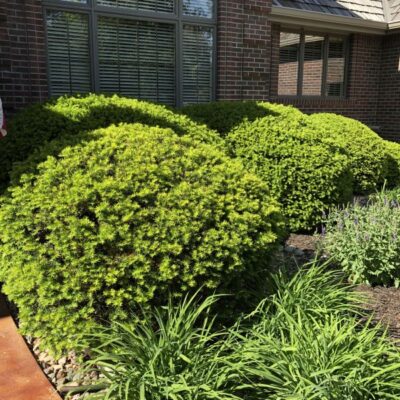Garden Plant: Densiformis Yew
Product Description: Densiformis Yew

Versatile, Hard-Working Densiformis Yew
- Rich, Dark Green Evergreen
- Year Round Color Gives Structure
- Versatile Plant
- Easy-Care Privacy and Hedging Plant
- Handles Sun and Shade
Plants become popular for a reason, whether it’s because they are easy care, beautiful, disease-resistant or simply look great anywhere. Densiformis Yew (Taxus x media \’Densiformis’) is popular for ALL of those reasons and then some.
One of the most popular evergreen shrubs today, you will find this beauty in residential foundation plantings, commercial landscapes and container gardens all over America.
We’re watching a renewed interest in the green foliage of Japanese Yews. People are loving this part shade loving evergreen. Classic Densiformis is back in a big way, but it has moved beyond the foundation planting.
It’s still great to bring year round color in foundation plantings, but people are also now using them in many other areas in the landscape.
Soft, fluffy, new growth in early spring gives the shrub bright green needles that continue to mature to a rich, deep green that holds all year round.
Densiformis responds beautifully to trimming much like a Boxwood does. Even when grown into its full shape naturally, this Yew looks fantastic in many different settings.
Order this beautiful “workhorse” shrub – the bigger, the better – and start innovating with this proven plant today!
How to Use Densiformis Yew in the Landscape
Japanese Yews like Densiformis make fantastic hedges and are great for adding structure to a garden even creating outdoor rooms. Whether sheared into formal hedges or rounded forms, or allowed to grow a bit more naturally, Yews are very easy to care for.
In winter, you need this lovely, rich dark green color to act as “bones” of the garden design. Use Densiformis as a beautiful backdrop for seasonal displays of perennials or smaller flowering shrubs. Give your design a sense of balance with evergreen Yews in the winter months.
Pair with Red Twigged Dogwoods and Ornamental Grasses for a wonderful look all winter long.
These shrubs have been tried and tested along the foundation of houses for decades. Simply put, these easy-care plants work. And remember, you don’t need a straight row of them, either.
Mix in roses, perennials or other flowering shrubs in your foundation plantings. Keep it lively with bright-eyed Potentilla. Or, join the Edible Garden trend and plant Blueberries or Huckleberries.
Consider adding a single Yew as a specimen in the corner of your house. In this case, we’d recommend that you don’t clip it into shape. Instead, allow it to grow to its natural mature size. It will instantly ground the landscape and add a ruggedly handsome presence.
Try a curved planting to define the walls of a Garden Room or Meditation Garden. You probably don’t want a fortress, but you do need a screen. In this application, give them room to grow naturally. You’ll adore the gentle sense of total privacy they bring on your patio, too.
In shaded areas, mass plant them as an understory plant and add Azaleas and Rhododendrons in the more shaded areas. Or, you can grow them in complete sun in the rose garden and sunny perennial gardens too.
Every way you might use a Boxwood, you can use a Japanese Yew. But Yews have a certain dignity about them. Specimens have been known to grow for thousands of years.
Dress them up as fancy pruned topiary – or dress them down in a rustic or contemporary yard. But for heaven’s sakes, use them!
Pro Plant Tips for Care
Densiformis, and all other Japanese Yew selections ask only one thing from you – perfectly well drained soils are a must. If you have any part of your landscape that stays wet a bit longer after rains, then avoid those areas.
Let’s say you really want to grow a Yew where the soil is too wet, you can simply raise the planting bed by adding some native soil on top of the area to raise the planting area and they will do fine. Most all soils are fine, and as we mentioned either full sun or complete shade and everything in between, and it grows beautifully.
Not only is it a low maintenance shrub, but Densiformis is tolerant to pollution, rabbits and seashore breezes.
If you are the pruning type, then after that first flush of growth, it is the time to prune. Usually by about the 4th of July. The natural method would be to just shorten up any elongated stems back into the body of the plant.
Naturally grown hedges make a fantastic soft barrier with really little upkeep. Sheared hedges really need one trim a year, best done early in summer, with a later summer nip and tuck of a few errant branches. It is better not to do shearing in the fall but after that first push of growth in spring, instead.
When growing Densiformis as a hedge, be sure to leave the lowest portion of the plant the widest and keep the tops a bit narrower. When you trim it this way, the plant will stay green right to the ground, which is what you want.
Older plants can be rejuvenated by trimming out longer portions of the plant back to a part of the stem that still has needles on it. It can then produce new buds and generate new growth from that point.
Densiformis Yew is an amazing evergreen that should not be left out of any landscape. Don’t miss this wonderful plant, order the largest size in stock today!


